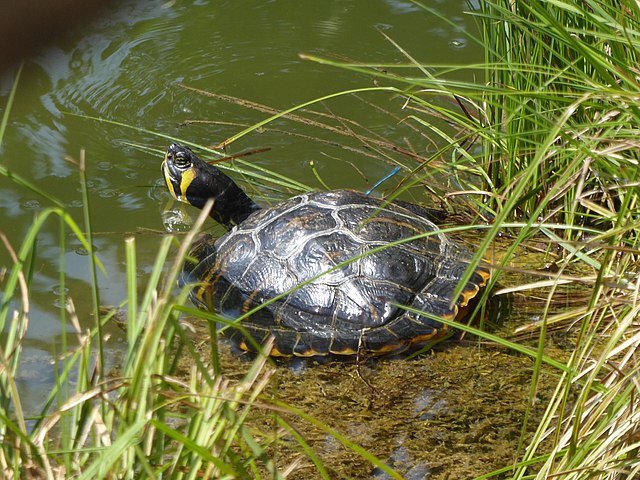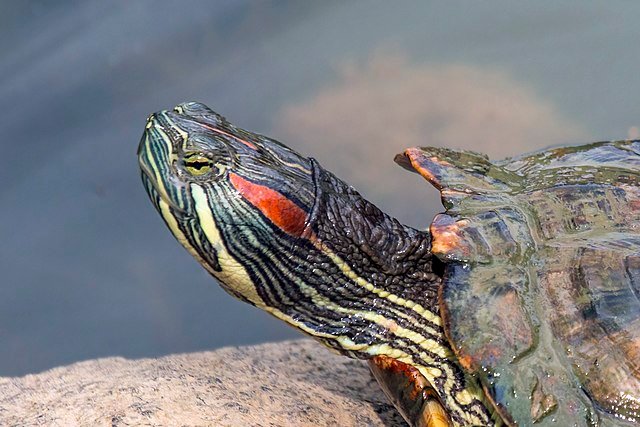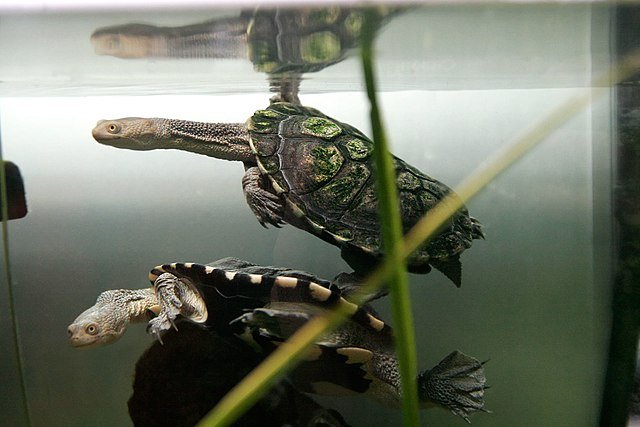
Have you ever wondered about the fascinating world of freshwater turtles? These amazing aquatic reptiles are popular as pets and companion aquatic animals worldwide.
Freshwater turtles have captured the attention of aquarium enthusiasts due to their iconic and unique nature. However, it’s essential to highlight that in many countries, they have become invasive due to the release of these animals into natural bodies of water.
In this article, we will immerse you in the exciting world of freshwater turtles. You will discover essential care, their diet, the secrets of their reproduction, and the various types of freshwater turtles that exist.
Species and Types of Freshwater Turtles
Freshwater turtles are reptiles; they are ectothermic or “cold-blooded.” The main difference between turtles and other reptiles is their shell, which is made up of bony plates. The shells are covered with horny shields made of keratin or leathery skin, depending on the species.
According to scientific reports, there are approximately 320 species of turtles worldwide, inhabiting a wide range of terrestrial, freshwater, and marine ecosystems on all continents.
Freshwater turtles are popular in aquariums due to their “charisma” and unique behavior. Here is a list of some of the main species of freshwater turtles commonly raised in aquariums:
Painted Turtle (Chrysemys picta)
This is one of the most common species of freshwater turtles in aquariums. Chrysemys picta is common in southern Canada, the United States, and northern Mexico, and it inhabits ponds, lakes, wetlands, and rivers with soft, muddy bottoms.
Painted turtles are characterized by their red and black shells and are known for their active and playful personalities. These turtles can have shells up to 25 cm in diameter.
Chrysemys picta comprises four subspecies: C. picta picta, C. picta marginata, C. pict dorsalis, and C. picta bellii.

Yellow-Bellied Slider Turtle (Trachemys scripta scripta)
Yellow-bellied slider turtles are recognizable by their long, yellow necks, and these turtles are highly popular in aquariums. They are active swimmers and can be quite sociable.
The natural habitat of these turtles is slow or still waters with muddy bottoms and abundant submerged or floating vegetation. Specialists recommend raising them in aquariums or ponds with a minimum depth of 40 cm and adorned with aquatic plants like Water Hyacinth, Duckweed, Water Lettuce, Elodea, and Anubia.
On the other hand, the water temperature should be maintained in the range of 25 to 35°C.
Trachemys scripta can reach a shell length of up to 40 cm; males have much longer and slimmer tails and longer nails than females.
Yellow-bellied slider turtles are omnivorous, and you can feed them with turtle pellets, insects, snails, slugs, tadpoles, and fish.

Map Turtle (Graptemys spp.)
Map turtles (Graptemys spp.) derive their name from the markings on their shells and are native to the eastern regions of North America. They are known for their shell patterns that resemble topographic maps. They are excellent swimmers and can be challenging to raise in captivity due to their specific water requirements.
The lifespan of map turtles ranges from 15 to 30 years. In their natural habitat, these aquatic turtles are found in river backwaters, although they can also inhabit swamps, meanders, lakes, and ponds.
Within the group of map turtles, the species G. gibbonsi exhibits significant sexual dimorphism, with females typically reaching a maximum shell length of 295 mm, while males reach 141 mm.

Red-Eared Slider Turtle (Trachemys scripta elegans)
They are similar in appearance to yellow-bellied slider turtles but are distinguished by the red markings on the sides of their heads. They are active and playful, making them popular in aquariums.
Owning a red-eared slider is a serious commitment as they can live up to 20 years (Kruzer, 2022) to 30 years in captivity. These turtles require an aquarium of at least 100 gallons of water.

Common Snapping Turtle (Chelydra serpentina)
These turtles are known for their prehistoric appearance and strong jaws. They require a large space and special care due to their size and behavior.
The common snapping turtle is also known as the ‘serpentine turtle’ or ‘alligator turtle’ and can reach a length of 49 cm. Chelydra serpentina is distributed from southern Canada, the eastern United States, southeastern Mexico, and in Colombia, Ecuador, and Costa Rica.
Chelydra serpentina inhabits swamps, ponds, rivers, lakes, and slow-moving streams.

Long-Necked Turtle (Chelodina longicollis)
Long-necked turtles, also known as snake-necked turtles, are native to Australia and are characterized by their long necks and streamlined bodies. In their natural habitat, they rest on the bottom of watercourses with their heads at the surface.
The long-necked turtle (Chelodina longicollis) requires a specific environment and is less common in aquariums, but it can be an intriguing choice for those seeking something different.
These turtles primarily feed on fish but can also consume amphibians, crustaceans, insects, and mollusks.

These are just some of the freshwater turtle species often bred and kept in aquariums. Each one has its own unique needs and characteristics, so it’s important to research and provide them with the appropriate environment and care to ensure their well-being in captivity.
What Do Freshwater Turtles Eat?
The diet of freshwater turtles is a significant concern. These creatures have a voracious appetite and require a balanced diet to stay healthy. Here are some important guidelines to follow:
- Balanced Diet: Feeding is a crucial aspect of care. Freshwater turtles are omnivorous, and their diet should include a variety of foods, such as commercial pellets, insects, fish, vegetables, and fruits. In this regard, Guo et al. (2016) reported the predation of red-eared slider turtles (Trachemys scripta elegans) on the ‘golden apple snail’ (Pomacea canaliculata). If you also breed freshwater snails, these can be a food source for your turtles.
- Proteins: Turtles need proteins in their diet to develop and maintain good health. You can feed them with fish, worms, and other insects.
- Vegetables and Fruits: In addition to proteins, make sure to provide them with vegetables and fruits for a balanced diet. Spinach, carrots, and apples are good choices.
On the other hand, it is recommended to provide aquatic turtles with a balanced diet that meets the minimum requirements in terms of nutrients and vitamins to prevent health problems.
Reproduction of Freshwater Turtles
Reproduction is a fascinating aspect of the life of freshwater turtles. These reptiles follow a unique process for procreation. The main reproductive strategy of freshwater turtles involves the courtship of the male and the choice by the female turtle. However, Moldowan (2015) described that in the case of the “painted turtle” (Chrysemys picta), males employ coercive tactics.
- Nesting: Females will seek a suitable place to nest, typically on land near the water. There, they will deposit their eggs, which will hatch after an incubation period.
- Parental Care: Freshwater turtle hatchlings are independent from the moment of hatching. They do not require maternal care and venture into the aquatic world on their own.
Care of Freshwater Turtles
We will begin by exploring the necessary care to keep these adorable creatures healthy and happy. Freshwater turtles are animals that require constant attention since their well-being depends significantly on the environment we provide for them. Here are some key considerations:
- Appropriate Habitat: Make sure to provide a clean and spacious aquatic environment. A large aquarium with an efficient filter is essential to maintain the water in optimal conditions. Additionally, the aquarium should have a ramp or a ledge for turtles to bask.
- Substrate: It is not recommended to use gravel as a substrate in aquariums or ponds for raising freshwater turtles. If you have no alternative, the gravel should be larger than the turtle’s mouth.
- Temperature and Light: Freshwater turtles need a proper heat source, such as a heat lamp, to maintain optimal water temperature. Adequate lighting is also crucial for their well-being.
- Ultraviolet B (UVB) Lighting: Ultraviolet B (UVB) light, in the range of 280 – 315 nm, is a vital component in turtle aquariums as it allows for the synthesis of vitamin D in captive reptiles. It is essential for maintaining and regulating calcium homeostasis (Alarcon, 2016).
- Enriched Environment: Bannister et al. (2021) found that introducing new, food-scented, colorful objects can be beneficial in reducing escape behavior in captive freshwater turtles like Trachemys scripta ssp.
Diseases Affecting Freshwater Turtles
If you suspect that your turtle has any disease, you should take it to a veterinarian specializing in reptiles.
When specialists perform minor procedures on a turtle, they usually anesthetize it. In this regard, Arnett-Chinn et al. (2016) reported an average dose of Midazolam recommended for freshwater turtles is 0.3 mg/kg, with up to 80% sedation achieved.
Hypovitaminosis A
An inadequate diet can lead to various health disorders in aquatic turtles. Hypovitaminosis is one of these disorders that can affect your turtle’s health.
Hypovitaminosis A results in the progressive breakdown of the epithelial tissue of the eyes in turtles that are less than a year old, leading to eye swelling. The primary cause of this condition is a lack of vitamin A.
Boro et al. (2022) recommend increasing the supplementation of vitamin A in the diet and feeding freshwater turtles with vegetables that are a rich source of vitamin A.
Risks of Raising Freshwater Turtles
One of the primary risks of raising freshwater turtles in aquariums is that these reptiles can be a direct or indirect source of Salmonella enterica transmission to humans. In this regard, Kaibu et al. (2006) reported that salmonellosis in two children in Japan was derived from the freshwater turtle Trachemys scripta elegans they had acquired weeks before.
Marin et al. (2016) reported the presence of Salmonella strains in 75% of freshwater turtles sold in the aquariums in the Valencia region of Spain. A similar result was obtained by Nurlifa (2018), who found the presence of the bacterium Salmonella sp. in 95% of aquatic turtles (Trachemys scripta elegans) acquired in the Surabaya market (Indonesia).
Conclusion
In summary, freshwater turtles are fascinating creatures that require specific care. From providing an appropriate environment to offering a balanced diet, these turtles deserve the proper attention.
The reproduction process and the variety of types of freshwater turtles available make them truly interesting aquatic animals. If you ever consider having a freshwater turtle as a pet, make sure you are prepared to provide the necessary care. Dive deeper into this exciting world and satisfy your curiosity about these impressive reptiles.
I hope this article has provided you with valuable information about freshwater turtles! If you want to learn more, continue exploring the aquatic world of these wonderful animals!
Bibliographical References
Alarcon, E. (2016). Effects of Ultra-violet B on the behavior of red-eared sliders (Trachemys scripta elegans). Animal Behavior and Conservation, Hunter College City University of New York
Arnett-Chinn, E. R., Hadfield, C. A., & Clayton, L. A. (2016). Review of intramuscular midazolam for sedation in reptiles at the National Aquarium, Baltimore. Journal of herpetological medicine and surgery, 26(1-2), 59-63.
Boro, P. K., Yadav, S. N., & Ahmed, N. (2022). Diagnosis of hypovitaminosis A in a red-eared slider turtle (Trachemys scripta elegans) and its successful therapeutic management. Indian Journal of Animal Health, 2.
Bannister, C. C., Thomson, A. J., & Cuculescu-Santana, M. (2021). Can colored object enrichment reduce the escape behavior of captive freshwater turtles? (Vol. 40, No. 2, pp. 160-168).
Guo, J., Zhang, C., Zhang, J. E., Xiang, Y., & Jiang, X. (2016). Predation and indirect interference effects of Trachemys scripta elegans on Pomacea canaliculata. Journal of South China Agricultural University, 37(6), 59-64.
Kaibu, H., Iida, K., Ueki, S., Ehara, H., Simasaki, Y., Anzai, H., … & Shirono, S. (2006). Salmonellosis of infants presumably originating from an infected turtle in Nagasaki, Japan. Japanese journal of infectious diseases, 59(4), 281.
Kruzer Adrienne. 2022. Red-Eared Slider: Species Profile – Characteristics, Housing, Diet, and Other Information. The Spruce Pets.
Marin, C., Vega, S., & Marco-Jiménez, F. (2016). Tiny turtles purchased at pet stores are a potential high risk for Salmonella human infection in the Valencian Region, Eastern Spain. Vector-Borne and Zoonotic Diseases, 16(7), 455-460.
Moldowan, P. D. (2015). Sexual dimorphism and alternative reproductive tactics in the Midland Painted Turtle (Chrysemys picta (marginata) (Doctoral dissertation, Laurentian University of Sudbury).
Nurlifa, Rindi Mahda (2018) Total kandungan bakteri dan deteksi bakteri Salmonella sp. pada air akuarium pemeliharaan kura – kura air (Trachemys scripta elegans). Other thesis, Wijaya Kusuma Surabaya University.
Editor at the digital magazine AquaHoy. He holds a degree in Aquaculture Biology from the National University of Santa (UNS) and a Master’s degree in Science and Innovation Management from the Polytechnic University of Valencia, with postgraduate diplomas in Business Innovation and Innovation Management. He possesses extensive experience in the aquaculture and fisheries sector, having led the Fisheries Innovation Unit of the National Program for Innovation in Fisheries and Aquaculture (PNIPA). He has served as a senior consultant in technology watch, an innovation project formulator and advisor, and a lecturer at UNS. He is a member of the Peruvian College of Biologists and was recognized by the World Aquaculture Society (WAS) in 2016 for his contribution to aquaculture.
